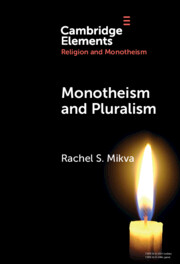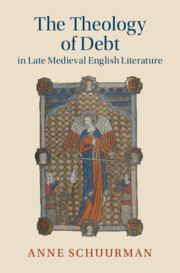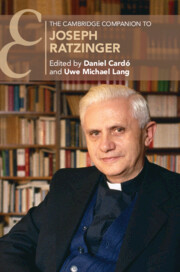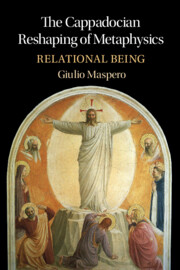293 results
2 - Languages of Belief
-
- Book:
- Some New World
- Published online:
- 29 March 2024
- Print publication:
- 18 April 2024, pp 24-67
-
- Chapter
- Export citation
24 - Pseudo-Aristotle, On the Cosmos (De mundo)
- from PART IV: - Roman Period
-
- Book:
- Geographers of the Ancient Greek World
- Published online:
- 25 March 2024
- Print publication:
- 18 April 2024, pp 663-683
-
- Chapter
- Export citation
Rowan Williams’ Theology of Revelation
-
- Journal:
- Journal of Anglican Studies , First View
- Published online by Cambridge University Press:
- 15 April 2024, pp. 1-10
-
- Article
- Export citation
Chapter 11 - T. S. Eliot
- from Part IV - Contemporaries
-
-
- Book:
- Robert Lowell In Context
- Published online:
- 28 March 2024
- Print publication:
- 04 April 2024, pp 121-129
-
- Chapter
- Export citation

Monotheism and Pluralism
-
- Published online:
- 23 March 2024
- Print publication:
- 04 April 2024
-
- Element
- Export citation
Chapter 4 - Liturgical ‘Usefulness’ and Reading the Ordines Romani
- from Part I - Compilation and Content of the Manuscripts
-
- Book:
- Roman Liturgy and Frankish Creativity
- Published online:
- 04 January 2024
- Print publication:
- 18 January 2024, pp 69-100
-
- Chapter
- Export citation

The Theology of Debt in Late Medieval English Literature
-
- Published online:
- 04 January 2024
- Print publication:
- 18 January 2024
Reconceiving Christianity and the Modern Prison: On Evangelicalism’s Eugenic Logic and Mass Incarceration
-
- Journal:
- Journal of Law and Religion / Volume 39 / Issue 1 / January 2024
- Published online by Cambridge University Press:
- 11 March 2024, pp. 85-115
- Print publication:
- January 2024
-
- Article
-
- You have access
- Open access
- HTML
- Export citation

The Cambridge Companion to Joseph Ratzinger
-
- Published online:
- 25 January 2024
- Print publication:
- 21 December 2023
Theologians Minor: Embracing Our Vocation with Humility
-
- Article
-
- You have access
- HTML
- Export citation
Chapter 14 - Messiaen’s Musical Language of Religious Symbolism
- from Part II - Messiaen and Theology
-
-
- Book:
- Messiaen in Context
- Published online:
- 09 November 2023
- Print publication:
- 30 November 2023, pp 127-134
-
- Chapter
- Export citation
Chapter 13 - The Theology and Aesthetics of Thomas Aquinas in the Compositions of Olivier Messiaen
- from Part II - Messiaen and Theology
-
-
- Book:
- Messiaen in Context
- Published online:
- 09 November 2023
- Print publication:
- 30 November 2023, pp 119-126
-
- Chapter
- Export citation
Chapter 16 - Messiaen and the Franciscan Spirit
- from Part II - Messiaen and Theology
-
-
- Book:
- Messiaen in Context
- Published online:
- 09 November 2023
- Print publication:
- 30 November 2023, pp 143-152
-
- Chapter
- Export citation

The Cappadocian Reshaping of Metaphysics
- Relational Being
-
- Published online:
- 11 January 2024
- Print publication:
- 09 November 2023
Chapter 2 - Early Modern
- from Part I - Literary Periods
-
-
- Book:
- The Cambridge Companion to Literature and Animals
- Published online:
- 26 October 2023
- Print publication:
- 09 November 2023, pp 38-56
-
- Chapter
- Export citation
2 - The Succor of Nations amidst the Confusion of Darkness by al-Juwaynī
- from Selected Theological Writings
-
- Book:
- Caliphate and Imamate
- Published online:
- 19 October 2023
- Print publication:
- 02 November 2023, pp 19-41
-
- Chapter
- Export citation
Introduction
-
- Book:
- Caliphate and Imamate
- Published online:
- 19 October 2023
- Print publication:
- 02 November 2023, pp x-lxii
-
- Chapter
- Export citation
1 - A Précis of the Doctrines of Abū ’l-Ḥasan al-Ashʿarī by Ibn Fūrak
- from Selected Theological Writings
-
- Book:
- Caliphate and Imamate
- Published online:
- 19 October 2023
- Print publication:
- 02 November 2023, pp 3-18
-
- Chapter
- Export citation
7 - The Crown of Doctrines and the Mine of Instructive Points by al-Dāʿī Ibn al-Walīd
- from Selected Theological Writings
-
- Book:
- Caliphate and Imamate
- Published online:
- 19 October 2023
- Print publication:
- 02 November 2023, pp 148-156
-
- Chapter
- Export citation
3 - The Theoretical Underpinning of the Imamate by Abū Ṭālib al-Hārūnī
- from Selected Theological Writings
-
- Book:
- Caliphate and Imamate
- Published online:
- 19 October 2023
- Print publication:
- 02 November 2023, pp 42-66
-
- Chapter
- Export citation



